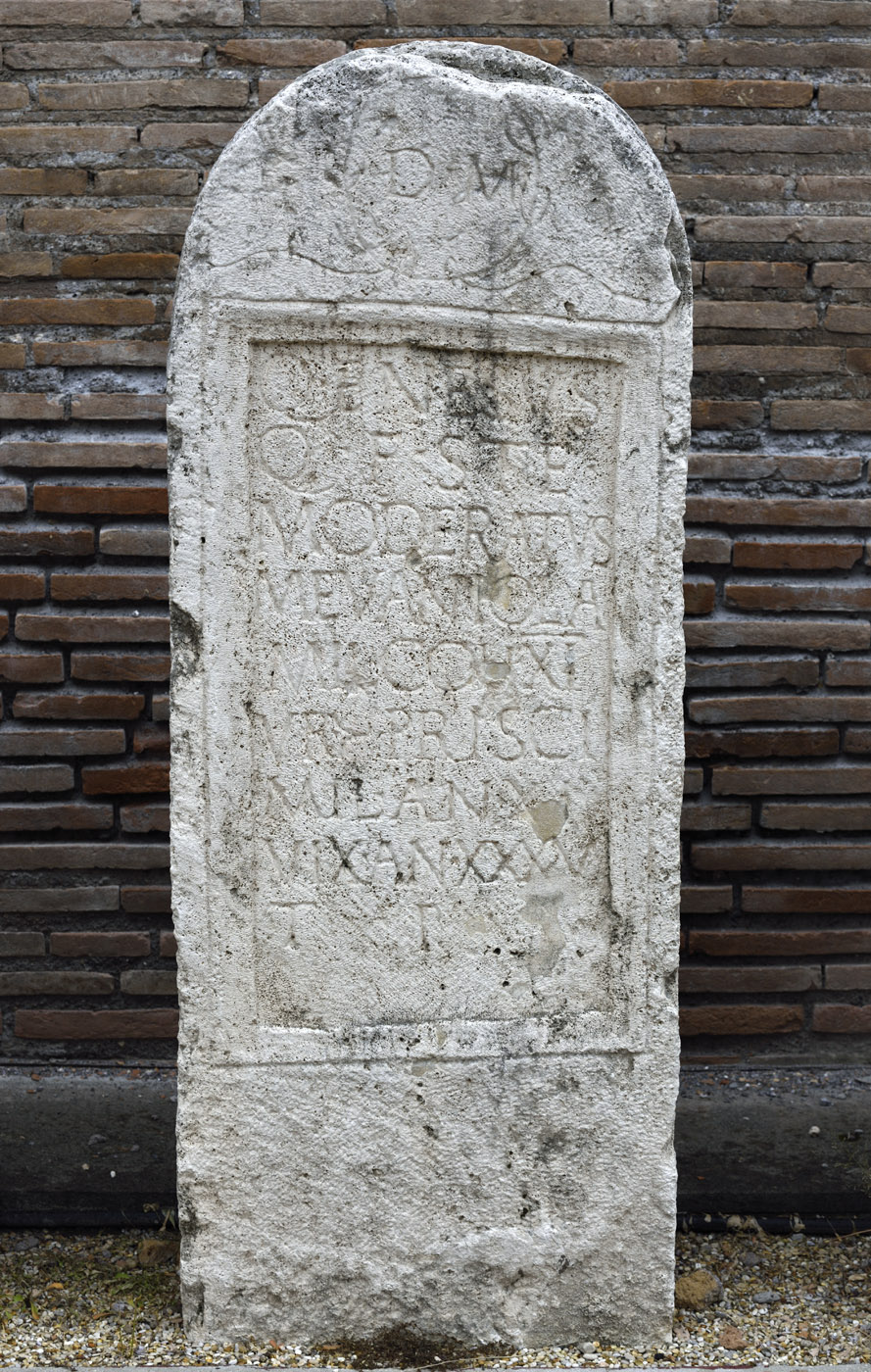
Travertine. Last third of the 1st — first third of the 2nd century CE.
Height 2 m width 0.58 m, depth 0.29 m. Inv. No. 125675.Rome, Roman National Museum, Baths of DiocletianPhoto by Ilya Shurygin
Funerary inscription of Quintus Eneius (Enesius?) Moderatus, soldier of an urban cohort.
Travertine. Last third of the 1st — first third of the 2nd century CE.
Height 2 m width 0.58 m, depth 0.29 m.
Rome, Roman National Museum, Baths of Diocletian
(Roma, Museo nazionale romano, Terme di Diocleziano).
| D(is) M(anibus). | |
| Q. Eneius (vel Enesius) | |
| Q. f. Ste(llatina) | |
| Moderatus, | |
| 5 | Mevaniola, |
| mil(es) coh(ortis) XI | |
| ur(banae), ((centuria)) Prisci, | |
| mil(itavit) an(nis) XII, | |
| vix(it) an(nis) XXXV, | |
| 10 | t(estamento) p(oni) i(ussit). |
To Gods Manes. Quintus Eneius (Enesius) Moderatus, son of Quintus, of Stellatina tribe, from Mevaniola, soldier of the XI urban cohort, of Priscus’ century, served for 12 years, lived for 35 years, ordered to set up (this inscription) in his testament.
Funerary steles of soldiers and bodyguards of Nero
The funerary steles are dedicated to soldiers of different corps stationed in Rome: the Praetorian Guard «the imperial guard» and the urbaniciani or cohortes urbanae troops of the police force. The series ends with the steles of Nero’s Imperial German Bodyguard — Germani corporis custodes — who were so called because they were originally recruited from the robust northern populations. Slaves at the time of Augustus, during the Neronian period the custodes were classed as free foreigners with a military-style organisation but without ever attaining the status of a real military force.
Involved in the death of Nero, they were dissolved by Galba.
Travertine from various areas of Rome and suburbs and the Via Portuensis. Neronian period (54—
 p.1396
p.1396
Stele funeraria di Q. Eneius Moderatus (inv. nr. 125675; fig. 6).
Travertino; h. cm 200; l. cm 58; spess. cm 29.
La superficie presenta varie scheggiature e abrasioni; due sfaldature interessano i margini del coronamento, in alto e a destra.
Stele funeraria centinata; nella lunetta è raffigurata una corona vittata ottenuta a compasso, con foglioline in forma di semicerchi piuttosto allungati (dello stesso tipo di quelle della stele n. inv. 125678 = V, 280); in basso due lunghe linee ondulate fungono da vittae. All’interno è scolpita la formula
 Nel campo epigrafico di cm
Nel campo epigrafico di cm D(is) M(anibus). Q. Eneius (vel Enesius) Q. f. Ste(llatina) Moderatus, 5 Mevaniola, mil(es) coh(ortis) XI ur(banae), ((centuria)) Prisci, mil(itavit) an(nis) XII, vix(it) an(nis) XXXV, 10 t(estamento) p(oni) i(ussit).
Il maggior interesse dell’epigrafe risiede nella tribù del pretoriano in quanto conferma che l’ascrizione tribale prevalente dei cittadini di Mevaniola (Galeata), nella regio VI, fu nella Stellatina; finora lo si era supposto sulla base di due iscrizioni di magistrati municipali (A. Donati, Aemilia tributim discripta, Faenza 1967, pp. 54 sg. nrr. 102—
Non si conoscono altri urbaniciani originari della città. Il gentilizio, con una I incisa sopra la S, si presta alla doppia lettura proposta sopra, a seconda che s’intenda la vocale sostituita o aggiunta alla p.1397 consonante (del tutto improbabile un nome Eneisus). D’altra parte, mentre non si hanno confronti per Enesius, se ne ha uno per Eneius (per di più associato allo stesso prenome Quintus) in altra iscrizione urbana relativa ad un pretoriano bononiense: Q. Eneius Q. f. Lem(onia) Montanus, Bononia (CIL, VI 2465).
Per una centuria Prisci nella coorte XI urbana, cfr. CIL, VI 2888, epigrafe che potrebbe essere però di datazione più tarda, nel corso del II sec. Notare l’età probabilmente solo approssimativamente indicata con un multiplo di 5. Per la consacrazione agli Dei Mani, vd. nr. inv. 125680 (= sett. V, 28q.).
AE 1979, 85.
Panciera S. Ambrogi A. Un sepolcreto di militari presso ponte Milvio // Museo Nazionale Romano. I. Le sculture. Vol. 7. 1. Roma, 1984. P. 169 nr. V 28m.
Panciera S. Epigrafi, epigrafia, epigrafisti. Scritti vari editi e inediti (1956—
AE 2011, 51
© Text of the inscription: Epigraphic Database Roma.
© Commentary: the museum label.
© Commentary: Panciera S. Epigrafi epigrafia epigrafisti. Scritti vari editi e inediti (1956—2005) con note complementari e indici. Roma 2006. P. 1396—1397.
© 2017. Translation: Olga Lyubimova.